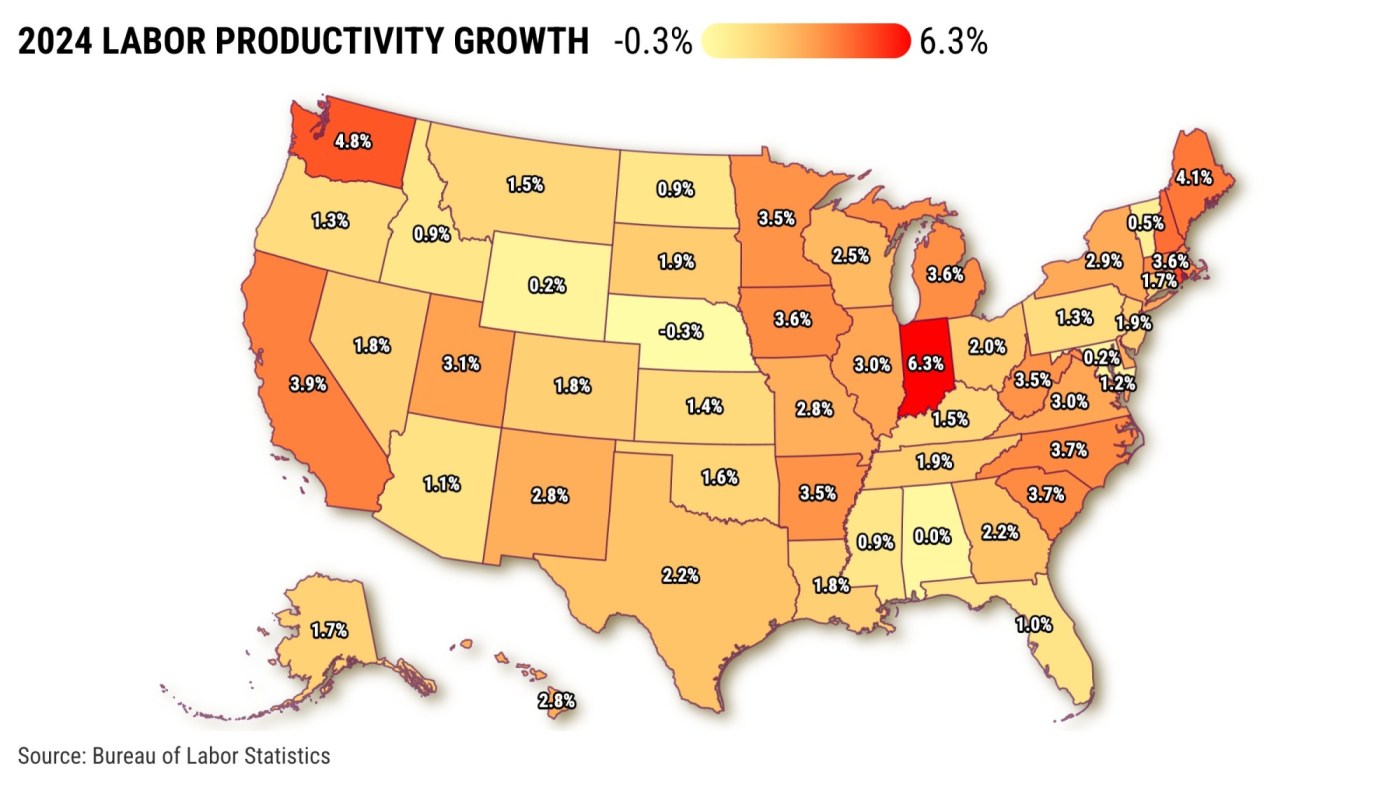
Let me offer one hint as to why California continues to be the nation’s No. 1 job market, despite its anti-business reputation.
Ponder a curious employment statistic known as “labor productivity,” which essentially tabulates the bang-for-the-buck that private sector bosses get from their workforce. My trusty spreadsheet reviewed the freshly minted state-by-state tally from the Bureau of Labor Statistics for 2024 for the 50 states and the District of Columbia.
Related Articles
Bay Area loses jobs in May as California posts modest gain
From the Bay Area to San Diego, California restaurants are on edge over ICE raids
San Jose mayor hopes Earthquakes will move downtown if soccer team is sold
At Home retailer closing San Jose stores in bankruptcy reorganization
US unemployment ticked down, hovering at historically low levels
Last year, California’s 17 million workers created productivity growth of 3.9% – the sixth-best result in the nation and nearly double the median 2% growth for all states.
Those Golden State workplace efficiencies tied 2008 for its third-biggest productivity yearly jump in the 17-year history of this statistic. The only time California did better was 2019’s 5.1% gain and pandemic-twisted 2020’s 8.2%.
Which states had more productive labor in 2024? That was Indiana at No. 1 with 6.3% growth, Rhode Island at 5%, Washington at 4.8%, New Hampshire at 4.3%, and Maine at 4.1%.
Conversely, the worst productivity was found in Nebraska, off 0.3%, and the only state with a decline. Then came Alabama, which was flat, Maryland and Wyoming, up 0.2%, and Vermont, up 0.5%.
And California’s economic arch-rivals? Texas – the No. 2 job market with 13 million workers – ranked No. 24, up 2.2%. No. 3 Florida, with 9.5 million workers, was No. 43, up just 1%.
The math
Productivity is a yardstick for measuring the efficiency juggle between what’s produced in a state and how much labor is needed to get the job done.
Let’s start with output growth. Last year, California ranked No. 9 at 3.6% vs. the 2.7% national median.
The best states were South Carolina at 4.8%, Indiana at 4.5%, and Utah at 4.2%. Oregon was lowest at 1.1%, then Alaska, Minnesota, and Wyoming at 1.4%.
And the rivals? Texas was No. 8 at 3.7% and Florida was No. 4 at 4%.
Next, ponder the time employees were on the clock.
California workers had their collective hours cut by 0.3% last year, ranking No. 37 among the states and below 0.4% median growth nationally. Just so you know, lean-and-mean staffing boosts productivity – at least for this math.
California was not alone with fewer hours worked, as 21 states had declines in 2024. The most significant dips were in Minnesota, off 2.1%, Iowa, off 1.9%, and Indiana, off 1.7%.
On the flip side, Florida workers gained the most hours last year, up 3%. Next came Alabama, up 2.8%, and Idaho, up 2.4%. Texas ranked No. 10, up 1.4%.
The report notes productivity isn’t just what workers do, rather it’s a mix of “many influences, including: changes in technology; capital investment; utilization of capacity, energy, and materials; the use of purchased services inputs, including contract employment services; the organization of production; the characteristics and effort of the workforce; and managerial skill.”
The history
Despite numerous criticisms of California’s business climate, lofty productivity is a long-running economic strength for the state.
Over 17 years, California ranks third-best in this productivity yardstick – averaging 2.4% annual growth vs. a median 1.5% for all states.
And what two states scored better? Tech-smart Washington state is at 3%, and energy-rich North Dakota is at 2.8%.
The national productivity laggards since 2007 were Louisiana and Wyoming, with 0.3%-a-year growth, and Connecticut at 0.5%.
And the rivals? Texas was No. 17 at 1.6% growth while Florida ranked No. 27 at 1.4%.
Paying up
The state’s bosses reward high productivity with generous pay hikes.
California’s 3.8% average annual increases in hourly compensation over these 17 years tied for fourth-best with North Dakota and South Dakota and bested the 3.3% median growth among the states. The only workers who fared better were in Washington (4.4% wage growth), Montana (4.2%), and Utah (3.9%).
This history shows the thinnest raises were in Connecticut, up 2.5% annually, Louisiana, up 2.7%, and Michigan and New Jersey, up 2.8%.
Since 2017, workers in rival Texas averaged 3.2% hikes, that’s a middling No. 31. Meanwhile, Florida ranked No. 8 with 3.6% increases.
Jonathan Lansner is the business columnist for the Southern California News Group. He can be reached at [email protected]